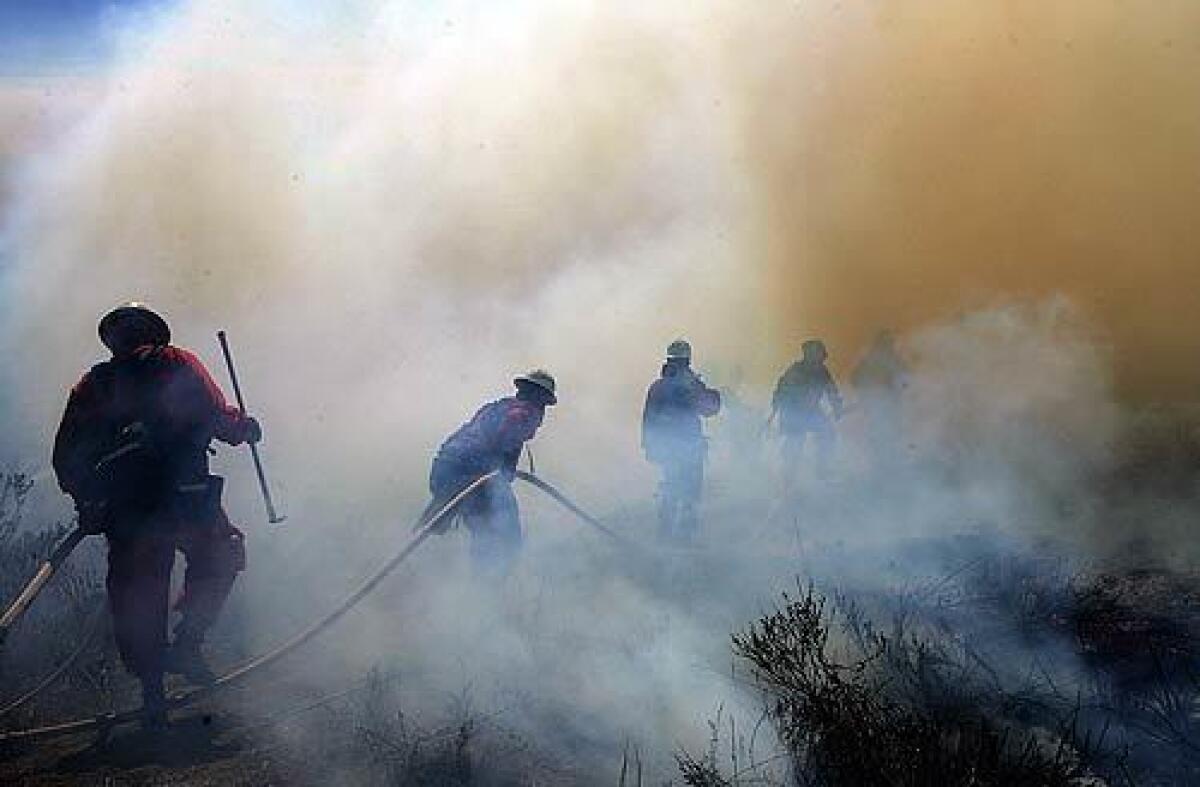Malibu residents see beauty in the face of destruction

Around every other bend of Las Floras Canyon Road, Malibu residents who defied official orders to evacuate gathered in small groups to bolster one another in their gamble.
They cheered each time a water-dropping aircraft roared overhead. They exchanged tales of others who had courted disaster in Malibu’s many past fires and lived to tell about it. There was the chap who immersed himself in his swimming pool, breathing through a straw poking above the surface. And the fellow who survived in scuba gear, submerged in his pool.
FOR THE RECORD:
Malibu fires: An article in Tuesday’s Section A about fires in Malibu misspelled Las Flores Canyon Road as Las Floras. —
As of Monday night, the Canyon fire had burned 3,800 acres of Malibu real estate, had destroyed or damaged 15 homes and was 8% contained.
Would residents’ decision to stay prove to be an intelligent choice or, as officials warned, the most stupid thing they could have done?
“You could say I’m trying to make educated guesses about combinations of terrain and wind,” said Michael Blum, a 36-year-old graphic designer, through a bandanna covering his face. Blum was among half a dozen residents transfixed by the glow on the ridgeline, imagining that their vigilance might somehow affect the course of events. “My guess is that this lower portion of the canyon is safe. If you feel you’re going to be safe, you try and stay as long as you can.”
A determined optimism abided also on the nearby fourth-story veranda of an architectural wonder, a home called The Phoenix because it rose from the ashes of the 1993 Malibu fire and is made of fireproof concrete and steel.
From that vantage point, which offered a panoramic view of the entire canyon, a trio calling themselves “Le Resistance” sipped beer and homemade absinthe as they watched billowing clouds of orange and red smoke rise from behind a distant ridge.
“It looks like the Chumash Indians are sending smoke signals, and we are reading them,” said actress Yvonne Delarosa, one of the three. “They’re saying it’s going to be all right for now.”
The common strain that kept people in place, and confirmed their determination to stay if the worst happened, was Malibu love, pure and simple.
Sixty-nine-year-old Robyn Morgan stood at the edge of her four acres atop Carbon Mesa Road and watched a helicopter douse a smoldering eucalyptus tree near her property. Around her neck was a nugget-like pendant -- the remains of her late husband’s watch, the only thing the couple were able to recover when their house burned in the 1993 Malibu fire.
“I never take it off,” she said.
Neither would she contemplate moving. . “The sky is blue, the ocean is crystal-clear. You can see the boats from here,” she said. “It’s just a pleasure. . . . I’m just spoiled. I got the world by the tail, except for the fires.”
Ed Murphy, a criminal-defense lawyer, has lived on Pacific Coast Highway for 16 years and has survived two major wildfires. Not even after the massive 1993 blaze did he contemplate living elsewhere. “I didn’t even give it a thought. . . . I live on the ocean. The ocean comes under my house. See my car there, the BMW? I never put the top up.”
At a police barricade set up at Las Floras Canyon and PCH, Jeff and Eryca Casper and their two small children stood on the canyon side, trying to make up their minds whether to cross. They had run out of food for their children, Dolphan, 3, and Bella, 10 months, and feared that the eight sheriff’s deputies guarding the barrier might not allow them to recross it and return home if they went for groceries.
Their son’s preschool at Malibu Presbyterian Church had burned down the day before. They were hardly strangers to catastrophe. They had lived near New York’s World Trade Center and had vivid memories of the aftermath of the destruction there Sept. 11, 2001, two months before they moved to Malibu.
“It’s deja vu, even though they’re different landscapes,” Eryca said. “It’s eerie -- the similarities. Whether it’s an urban landscape or more rural, it’s always very humbling -- the fragility of life.”
Mike Tuttle, in board shorts and bare feet, walked along PCH and whistled a tune. To the north, a thick cloud of yellow-white smoke was edging toward the water, and helicopters chopped the air above.
“It’s Malibu!” he said, and chuckled. “You wake up every morning and see this.” But the ocean, to which he was referring, was becoming more obscured by smoke, and Tuttle’s eyes were red with irritation.
“I don’t listen to anyone in Malibu complain. After all, they could be living in the Valley.”
Times staff writers James Ricci, Carla Hall, Anna Gorman, Hector Becerra and Stuart Pfeifer contributed to this report.
More to Read
Sign up for Essential California
The most important California stories and recommendations in your inbox every morning.
You may occasionally receive promotional content from the Los Angeles Times.











